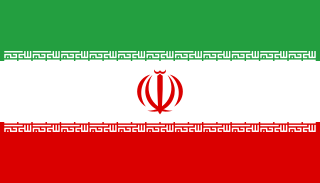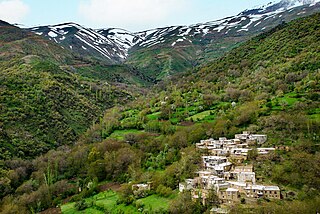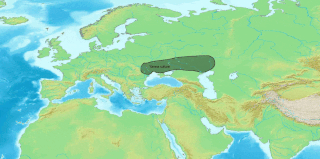
Persian, also known by its endonym Farsi, is a Western Iranian language belonging to the Iranian branch of the Indo-Iranian subdivision of the Indo-European languages. Persian is a pluricentric language predominantly spoken and used officially within Iran, Afghanistan, and Tajikistan in three mutually intelligible standard varieties, namely Iranian Persian, Dari Persian, and Tajiki Persian. It is also spoken natively in the Tajik variety by a significant population within Uzbekistan, as well as within other regions with a Persianate history in the cultural sphere of Greater Iran. It is written officially within Iran and Afghanistan in the Persian alphabet, a derivative of the Arabic script, and within Tajikistan in the Tajik alphabet, a derivative of the Cyrillic script.

Iran, also known as Persia and officially the Islamic Republic of Iran (IRI), is a country in West Asia. It is bordered by Iraq to the west and Turkey to the northwest, Azerbaijan, Armenia, the Caspian Sea and Turkmenistan to the north, Afghanistan to the east, Pakistan to the southeast, the Gulf of Oman and the Persian Gulf to the south. It covers an area of 1.64 million square kilometers, making it the world's 17th-largest country. Iran has around 90 million people, making it the world's 17th most populous country. Its capital and largest city is Tehran with around 16 million people in its metropolitan area.
The Persians are an Iranian ethnic group who comprise over half of the population of Iran. They share a common cultural system and are native speakers of the Persian language as well as of the languages that are closely related to Persian. Historically, people from Iran called themselves Persian as a nationality,, regardless of their ethnic background due to its historical usage as a xenonym.

Kurdish is a language or a group of languages spoken by Kurds in the geo-cultural region of Kurdistan and the Kurdish diaspora. Kurdish languages constitutes a dialect continuum, many of which are not mutually intelligible, belonging to Western Iranian languages in the Indo-European language family. The main three dialects or languages of Kurdish are Northern Kurdish, Central Kurdish, and Southern Kurdish.

Avestan is an umbrella term for two Old Iranian languages: Old Avestan and Younger Avestan. They are known only from their conjoined use as the scriptural language of Zoroastrianism, and the Avesta likewise serves as their namesake. Both are early Eastern Iranian languages within the Indo-Iranian language branch of the Indo-European language family. Its immediate ancestor was the Proto-Iranian language, a sister language to the Proto-Indo-Aryan language, with both having developed from the earlier Proto-Indo-Iranian language; as such, Old Avestan is quite close in both grammar and lexicon to Vedic Sanskrit, the oldest preserved Indo-Aryan language.

Hormozgan Province is one of the 31 provinces of Iran. It is in the south of the country, in Iran's Region 2, facing Oman, UAE and the Hormuz Straits. Its area is 70,697 km2 (27,296 sq mi), and its provincial capital is Bandar Abbas. The province has fourteen islands in the Persian Gulf and 1,000 km (620 mi) of coastline.

Kurdistan or Kordestan province is one of the 31 provinces of Iran. The province is 28,817 km2 in area and its capital is the city of Sanandaj. Other counties with their major cities are Saqqez, Baneh, Marivan, Qorveh, Piranshahr, Bijar, Kamyaran, Dehgolan, Diwandarreh and Sarvabad.

Iran is subdivided into thirty-one provinces, each governed from a local centre, usually the largest local city, which is called the capital of that province. The provincial authority is headed by a governor-general, who is appointed by the Minister of the Interior subject to approval of the cabinet.

East Azerbaijan Province is one of the 31 provinces of Iran. It is located in Iranian Azerbaijan, bordering Armenia, Republic of Azerbaijan, Ardabil province, West Azerbaijan province, and Zanjan province. The capital of the province is Tabriz. East Azerbaijan province is in Region 3 of Iran, with its secretariat located in its capital city, Tabriz.
The nuclear program of Iran is an ongoing scientific, technological and industrial effort to research and produce nuclear technology in Iran. Iran has several research sites, two uranium mines, a research reactor, and uranium processing facilities that include three known uranium enrichment plants.

Iranian mythology is the body of the myths originally told by ancient Persians and other Iranian peoples, and a genre of Ancient Persian folklore. These stories concern the origin and nature of the world, the lives and activities of deities, heroes, and mythological creatures, and the origins and significance of the ancient Persians' own cult and ritual practices. Modern scholars study the myths to shed light on the religious and political institutions of not only modern-day Iran but the Greater Iran, which includes regions of West Asia, Central Asia, South Asia and Transcaucasia where Iranian culture has had significant influence. Historically, these were regions long ruled by dynasties of various Iranian empires, that incorporated considerable aspects of Persian culture through extensive contact with them, or where sufficient Iranian peoples settled to still maintain communities who patronize their respective cultures. It roughly corresponds to the Iranian plateau and its bordering plains. The Encyclopædia Iranica uses the term Iranian Cultural Continent for this region.

The Islamic Republic of Iran Broadcasting formerly called National Iranian Radio and Television until the Iranian revolution of 1979, is an Iranian state-controlled media corporation that holds a monopoly of domestic radio and television services in Iran. It is also among the largest media organizations in Asia and the Pacific region and a regular member of the Asia-Pacific Broadcasting Union. Its head is appointed directly by the Supreme Leader, Ayatollah Ali Khamenei.
Schneidereria is a genus of moth in the family Gelechiidae.

The Embassy of the United States of America in Tehran was the American diplomatic mission in the Imperial State of Iran. Direct bilateral diplomatic relations between the two governments were severed following the Iranian Revolution in 1979, and the subsequent seizure of the embassy in November 1979.
The Iranian Department of Environment is a governmental organization, under the supervision of the president, that is responsible for matters related to safeguarding the environment.
Schneidereria pistaciella is a moth of the family Gelechiidae. It is found in Ukraine, Greece, Cyprus, Syria and possibly Iraq and Iran.
Schneidereria platyphracta is a moth of the family Gelechiidae. It is found in southern India.

The Islamic Republic of Iran Army, acronymed AJA, simply known as the Iranian Army or the Artesh, is the conventional military of Iran and part of the Islamic Republic of Iran Armed Forces. It is tasked to protect the territorial integrity of the country from external and internal threats and to project power.

The Sarabi dog or Iranian mastiff or Persian mastiff (Persian:پرشین ماستیف) is a large breed of livestock guardian dog from Iran, originating from the Sarab Country in Azerbaijan of Iran, Sarabi dogs have been used for centuries by local shepherds to protect herds of sheep and goats from bears, wolves, jackals and other local predators. The Sarabi mastiff is calm, controlled, independent, powerful and protective; the breed is also used to compete in staged dog fights. The breed is considered one of the oldest and most powerful indigenous dog breeds in Iran; the larger and heavier an individual dog is, the greater its value.












